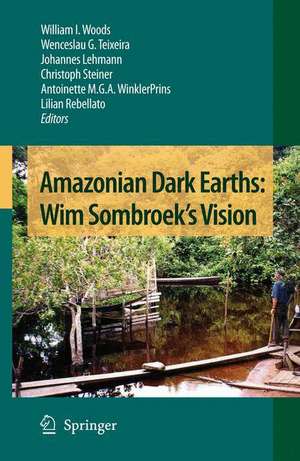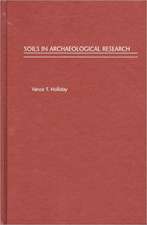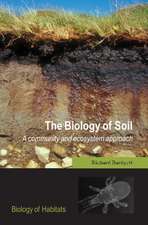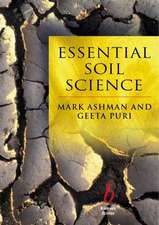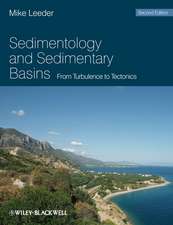Amazonian Dark Earths: Wim Sombroek's Vision
Editat de William I. Woods, Wenceslau G. Teixeira, Johannes Lehmann, Christoph Steiner, Antoinette M. G. A. WinklerPrins, Lilian Rebellatoen Limba Engleză Hardback – 9 dec 2008
Wim saw not only the possibilities of improving the lives of small holders throughout the world with simple carbon based soil technologies, but was an early proponent of the positive synergies also achieved in regards to carbon sequestration and global climatic change abatement. Wim’s vision was to form a multidisciplinary group whose members maintained the ideal of open collaboration toward the attainment of shared goals. Always encouraged and often shaped by Wim, this free association of international scholars termed the “Terra Preta Nova” Group came together in 2001 and has flourished. This effort has been defined by enormous productivity. Wim who is never far from any of our minds and hearts, would have loved to share the great experience of seeing the fruits of his vision as demonstrated in this volume.
| Toate formatele și edițiile | Preț | Express |
|---|---|---|
| Paperback (1) | 1227.67 lei 6-8 săpt. | |
| SPRINGER NETHERLANDS – 10 noi 2010 | 1227.67 lei 6-8 săpt. | |
| Hardback (1) | 1239.37 lei 6-8 săpt. | |
| SPRINGER NETHERLANDS – 9 dec 2008 | 1239.37 lei 6-8 săpt. |
Preț: 1239.37 lei
Preț vechi: 1511.42 lei
-18% Nou
Puncte Express: 1859
Preț estimativ în valută:
237.14€ • 248.93$ • 196.84£
237.14€ • 248.93$ • 196.84£
Carte tipărită la comandă
Livrare economică 10-24 aprilie
Preluare comenzi: 021 569.72.76
Specificații
ISBN-13: 9781402090301
ISBN-10: 1402090307
Pagini: 360
Ilustrații: XXIV, 502 p. 8 illus. in color.
Dimensiuni: 155 x 235 x 40 mm
Greutate: 1.07 kg
Ediția:2009
Editura: SPRINGER NETHERLANDS
Colecția Springer
Locul publicării:Dordrecht, Netherlands
ISBN-10: 1402090307
Pagini: 360
Ilustrații: XXIV, 502 p. 8 illus. in color.
Dimensiuni: 155 x 235 x 40 mm
Greutate: 1.07 kg
Ediția:2009
Editura: SPRINGER NETHERLANDS
Colecția Springer
Locul publicării:Dordrecht, Netherlands
Public țintă
ResearchCuprins
Amazonian Dark Earths: The First Century of Reports.- Pre-Columbian Settlement Dynamics in the Central Amazon.- Steps Towards an Ecology of Landscape: The Pedo-Stratigraphy of Anthropogenic Dark Earths.- Phytoliths and Terra Preta: The Hatahara Site Example.- Anthropogenic Dark Earths of the Central Amazon Region: Remarks on Their Evolution and Polygenetic Composition.- An Assessment of the Cultural Practices Behind the Formation (or Not) of Amazonian Dark Earths in Marajo Island Archaeological Sites.- Kayapó Savanna Management: Fire, Soils, and Forest Islands in a Threatened Biome.- Amerindian Anthrosols: Amazonian Dark Earth Formation in the Upper Xingu.- Indigenous Knowledge About Terra Preta Formation.- Sweep and Char and the Creation of Amazonian Dark Earths in Homegardens.- Pedology, Fertility, and Biology of Central Amazonian Dark Earths.- Historical Ecology and Dark Earths in Whitewater and Blackwater Landscapes: Comparing the Middle Madeira and Lower Negro Rivers.- Amazonian Dark Earths in Africa?.- Locating Amazonian Dark Earths (ADE) Using Satellite Remote Sensing – A Possible Approach.- The Microbial World of Terra Preta.- Microbial Response to Charcoal Amendments and Fertilization of a Highly Weathered Tropical Soil.- Effects of Charcoal as Slow Release Nutrient Carrier on N-P-K Dynamics and Soil Microbial Population: Pot Experiments with Ferralsol Substrate.- Terra Preta Nova: The Dream of Wim Sombroek.- Microbial Population and Biodiversity in Amazonian Dark Earth Soils.- Spectroscopy Characterization of Humic Acids Isolated from Amazonian Dark Earth Soils (Terra Preta De Índio).- Solid-State 13C Nuclear Magnetic Resonance Characterisation of Humic Acids Extracted from Amazonian Dark Earths (Terra Preta De Índio).- Opening the Black Box: Deciphering Carbon and Nutrient Flows in Terra Preta.- Charcoal Making in the Brazilian Amazon: Economic Aspects of Production and Carbon Conversion Efficiencies of Kilns.- The Effect of Charcoal in Banana (Musa Sp.)Planting Holes – An On-Farm Study in Central Amazonia, Brazil.- Characterization of Char for Agricultural Use in the Soils of the Southeastern United States.- Black Carbon (Biochar) in Rice-Based Systems: Characteristics and Opportunities.- City to Soil: Returning Organics to Agriculture – A Circle of Sustainability.- Terra Preta Nova – Where to from Here?.
Recenzii
From the reviews:
"Amazonian Dark Earths: Wim Sombroek’s Vision is a wonderful account of the history and science of anthropogenic soils. … Amazonian Dark Earths: Wim Sombroek’s Vision is a landmark book. … Amazonian Dark Earths: Wim Sombroek’s Vision is a must read for students and scholars of landscape geography." (Mike Dubrasich, Western Institute for Study of the Environment, February, 2009)
“This new volume … provides an excellent reference and point of entry for readers seeking a substantive, multidisciplinary overview of the state of knowledge on ADE. … Chapter formats are consistent throughout the volume, and most chapters are well illustrated with black and white maps, graphs, and photos. … It will be valuable for those working with Amazonian Dark Earths or related soils and to readers, from a wide range of academic disciplines, with an interest in Wim Sombroek’s legacy.” (Carol Harden, Vadose Zone Journal, Vol. 9, 2010)
"Amazonian Dark Earths: Wim Sombroek’s Vision is a wonderful account of the history and science of anthropogenic soils. … Amazonian Dark Earths: Wim Sombroek’s Vision is a landmark book. … Amazonian Dark Earths: Wim Sombroek’s Vision is a must read for students and scholars of landscape geography." (Mike Dubrasich, Western Institute for Study of the Environment, February, 2009)
“This new volume … provides an excellent reference and point of entry for readers seeking a substantive, multidisciplinary overview of the state of knowledge on ADE. … Chapter formats are consistent throughout the volume, and most chapters are well illustrated with black and white maps, graphs, and photos. … It will be valuable for those working with Amazonian Dark Earths or related soils and to readers, from a wide range of academic disciplines, with an interest in Wim Sombroek’s legacy.” (Carol Harden, Vadose Zone Journal, Vol. 9, 2010)
Textul de pe ultima copertă
Amazonian soils are almost universally thought of as extremely forbidding. However, it is now clear that complex societies with large, sedentary populations were present for over a millennium before European contact. Associated with these are tracts of anomalously fertile, dark soils termed terra preta or dark earths. These soils are presently an important agricultural resource within Amazonia and provide a model for developing long-term future sustainability of food production in tropical environments. The late Dutch soil scientist Wim Sombroek (1934-2003) was instrumental in bringing the significance of these soils to the attention of the world over four decades ago.
Wim saw not only the possibilities of improving the lives of small holders throughout the world with simple carbon based soil technologies, but was an early proponent of the positive synergies also achieved in regards to carbon sequestration and global climatic change abatement. Wim’s vision was to form amultidisciplinary group whose members maintained the ideal of open collaboration toward the attainment of shared goals. Always encouraged and often shaped by Wim, this free association of international scholars termed the Terra Preta Nova Group came together in 2001 and has flourished. This effort has been defined by enormous productivity. Wim who is never far from any of our minds and hearts, would have loved to share the great experience of seeing the fruits of his vision as demonstrated in this volume.
Wim saw not only the possibilities of improving the lives of small holders throughout the world with simple carbon based soil technologies, but was an early proponent of the positive synergies also achieved in regards to carbon sequestration and global climatic change abatement. Wim’s vision was to form amultidisciplinary group whose members maintained the ideal of open collaboration toward the attainment of shared goals. Always encouraged and often shaped by Wim, this free association of international scholars termed the Terra Preta Nova Group came together in 2001 and has flourished. This effort has been defined by enormous productivity. Wim who is never far from any of our minds and hearts, would have loved to share the great experience of seeing the fruits of his vision as demonstrated in this volume.
Caracteristici
Carbon sequestration Sustainable tropical soil management Forgotten Amazonian Indian technologies of soil management A unique collection of Terra Preta research A vision for the future of tropical soil management
